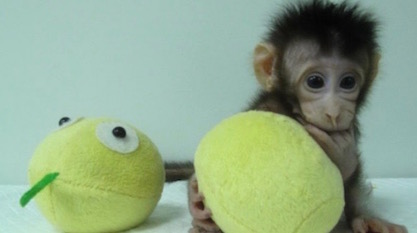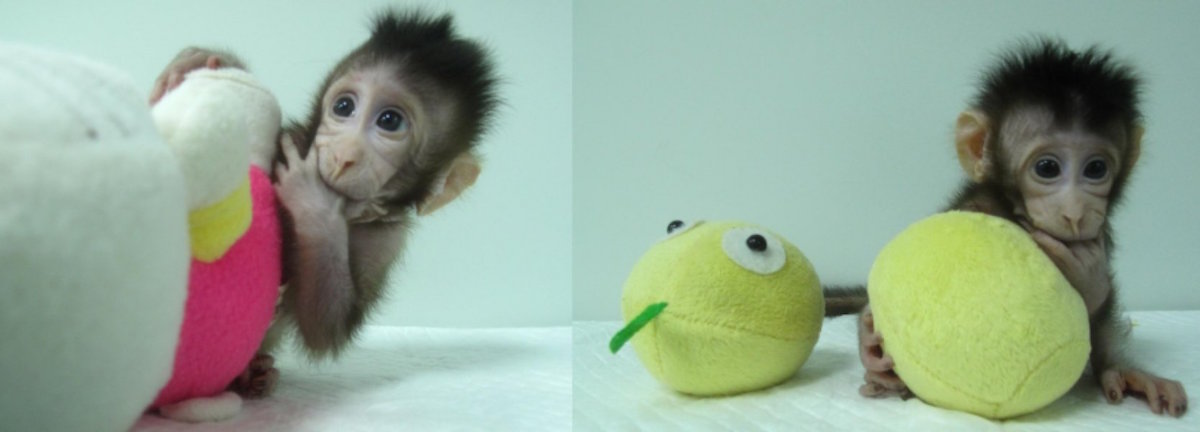 Culture & Ethics
Culture & Ethics
 Life Sciences
Life Sciences
 Medicine
Medicine
Monkey Clones: Harbingers of Things to Come?


A hot story has recently dominated science news: the cloning of macaque monkeys by somatic cell nuclear transfer. Wesley Smith wrote about it here. An amazing technical accomplishment, it also elicits dread. The Sun, in the United Kingdom, labeled the cloning “Monstrous,” saying, “The cloning of Macaques Zhong Zhong and Hua Hua have prompted fears from critics the technique will be used to create humans.”
And rightly so.
In the process of considering this story I ran across the following:
Oregon Dispensaries know our clones and there’s a reason why….. Our #1 priority is to delivery Healthy, Established, Lush, Problem Free Clones to your facility. We know how important a healthy clone is and we will never send product out our doors without it meeting Green Monkey’s strict standard.
“My God!” I thought for a brief moment. Then I realized they were talking about Cannabis clones, but still, for that first instant I was horrified, imagining a day when such an advertisement might be written about human clones.
Images from science fiction stories filled my head. The idea of replicated humans goes back as far as 1939 to William F. Temple‘s ”Four-Sided Triangle” (in Amazing Stories), and remains a common theme. More recent films to use the idea include The Clone Master (1978), Superman IV: The Quest for Peace (1987), Alien Resurrection (1997), Gattaca (1997), The 6th Day (2000), Replicant (2001), and Star Wars: Episode II – Attack of the Clones (2002).
Cloning strikes at the heart of our sense of individuality, and our concern about the status of any humans that are clones. Books and movies evoke fears of clones treated as third class citizens, even being used as sources of spare body parts. Whether clones could be considered fully persons, whether they would even have souls, has been debated both in books and in the media each time a cloning advance is made.
The most horrifying aspect of cloning would be that clones might be considered utilitarian objects, for use by the “owner” as he or she wills, as a means of extending life or achieving immortality, or to replace a dead child or lover. Clones might be viewed as replaceable, easily cast away once their use is fulfilled. We as a society already struggle with utilitarianism, where some view human beings as of worth only if they are useful, functional, contributing members of society. Disabled, elderly, and the very young and unborn are devalued. We already struggle with organ trafficking, and the sale of embryo parts for research. Euthanasia and abortion threaten the elderly and disabled. How could our society survive the existence of a class of humans created not out of love, or even desire, but as a means to an end?
Why do scientists pursue this in the face of such societal concerns? In all honesty, it’s the thrill of being the first to do something that has never been done before, along with sheer curiosity, “I wonder what will happen if…” Just a short history reveals how one step leads to the next. Hans Driesch artificially caused sea urchin embryos to split, producing twins that each developed into adults. He thus showed that both cells had all the necessary information to grow — this in 1885. The same was done in vertebrates by Hans Spemann in 1902. The first successful nuclear transfer occurred in 1952, by Briggs and King. They transferred an embryonic salamander nucleus into an enucleated frog egg, and obtained cloned salamanders, showing that the nucleus directed development. Next in 1958 Gurdon did the same thing, but with an adult frog nucleus into frog eggs.
The first mammalian embryo created by nuclear transfer happened in 1975. In 1984 sheep embryos were cloned by nuclear transfer, all the way to three live lambs. Then again in 1987 with cows. Finally, in 1996 came the cloning of the sheep Dolly using adult cells as the nuclear donor, for the first time in mammals.
This woke everybody up to the reality and potential danger of cloning. Presidential panels were called, one by Clinton, and another by Bush. Recommendations were made to restrict cloning, but no federal laws were passed. The most that was done was to place a restriction on federal funding of research on cloning. Some states passed laws, but the regulatory environment was full of holes, through which dedicated researchers could drive a truckload of experiments.
I remember these debates and the recommendations. I assumed that legislation was in place to restrict cloning. I have since discovered that I was wrong. There is no law, even against reproductive cloning, on the federal books.
Why did nothing get passed? Well, you see, there are two types of cloning. In one type, the embryo is harvested for stem cells or for research. That’s called therapeutic cloning because it is proposed that this research may lead to cures for diseases. This is the holy grail for many researchers — access to embryonic cells with all their potential for transformation into various tissues. For the other kind of cloning, called reproductive cloning, the embryo is not harvested, but placed in the womb of a female of the species, and allowed to come to term and be born. Scientists agreed, no, there would be no reproductive cloning of humans (though some to this day argue in favor of it). However. they argued strenuously in favor of therapeutic cloning. And they won. No federal legislation was passed except a ban on federal funding of cloning research, including stem cells.
This ban has done little to hinder research on therapeutic cloning.
I must point out that both types of cloning are reprehensible. Both involve the creation of a human life by artificial means — the transfer of a somatic cell nucleus or embryonic cell nucleus into an egg whose own nucleus has been removed. The result, if it grows, is a human embryo. Full stop. Whether it is harvested, or fails to develop, or implants and goes full term, it is a human being, an artificially created being, certainly, but with the same potential as any other human embryo.
It took more than twenty years from the cloning of Dolly the sheep until the successful cloning of a monkey from a fibroblast cell as reported this month. Counting Dolly, 23 other species have been cloned, including mouse, cattle, pig, cat, rat, and dog. There have even been several reports that humans have already been cloned. From the article on reproductive cloning at the website BioCentre, a UK think tank concerned with the ethical, social, and political implications presented by emerging technologies:
Despite this widespread opposition to reproductive cloning, some scientists have nonetheless pursued this goal, and several claim to have successfully cloned humans, and even to have brought some to term.
- The first human clone, a healthy 7-pound girl named Eve, was born on the 26th of December 2002, according to Clonaid, a private company linked to the Raelian religious sect. (The Raelians believe that human life was created in an alien laboratory, and that human cloning provides the opportunity for human immortality.) The claim was never verified
- In 2003 Panayiotis M Zavos, Professor Emeritus of Reproductive Physiology and Andrology at the University of Kentucky, claims to have cloned a human embryo but to have cryopreserved it at an early stage of development.
- In November 2002, Dr Severino Antinomy announced that he had successfully used cloning to induce pregnancy in three women, with birth of the first child expected in January 2003. There is widespread skepticism about the truth of these claims.
So now we have two cute little monkey clones. Primates have been the last barrier in reproductive cloning, very difficult to achieve. So it is no wonder to see all the attention that has been given to the article, “Cloning of Macaque Monkeys by Somatic Cell Nuclear Transfer,” by Liu et al. The authors state in their abstract:
This study demonstrated that cloning of non-human primates is feasible by SCNT [somatic cell nuclear transplant] using fetal somatic cells, which could be efficiently modified by genetic editing and screening in vitro (Gao et al., 2017, Lai et al., 2016, Rogers, 2016). Such cloning allows the production of genetically uniform monkeys as animal models for basic research in primate biology and for studying human disease mechanisms and therapeutic treatments. [Emphasis added.]
In other words, having cloned organisms makes experiments easier — you can compare results between individuals that are nearly genetically identical, removing a large source of experimental error. In the process of cloning you can also modify them genetically, or screen them for defects. That was slipped in quietly, wasn’t it? Genetic engineering and cloning, very modest and pragmatic.
The paper describes how difficult the experiment was, though: many embryos died before the right techniques were found, and almost all failed to make it through gestation or birth. Out of 127 eggs injected with somatic cell nuclei, 79 were transferred into surrogate mothers. Six pregnancies resulted, giving rise to two live births. It remains to be seen how healthy these cute little monkey clones will be. Clearly this is a very low-yield process, with losses all along the way. And this calculus does not include the other part of the experiment where they tried a different method, using 290 eggs, resulting in 22 pregnancies and 2 live births but no surviving monkeys. Now imagine this when talking about human cloning.
From all this it should be clear: while this may be a scientific breakthrough, it comes with a very high price tag, monetarily, and morally. And the scientific community has neither the will nor the means to regulate itself. As long as someone is willing to fund the research, someone will try.
Let us hope, fervently, that the scientific and regulatory communities act to prohibit the next step.
Photo credit: Qiang Sun and Mu-ming Poo / Chinese Academy of Sciences, via Science Daily.
